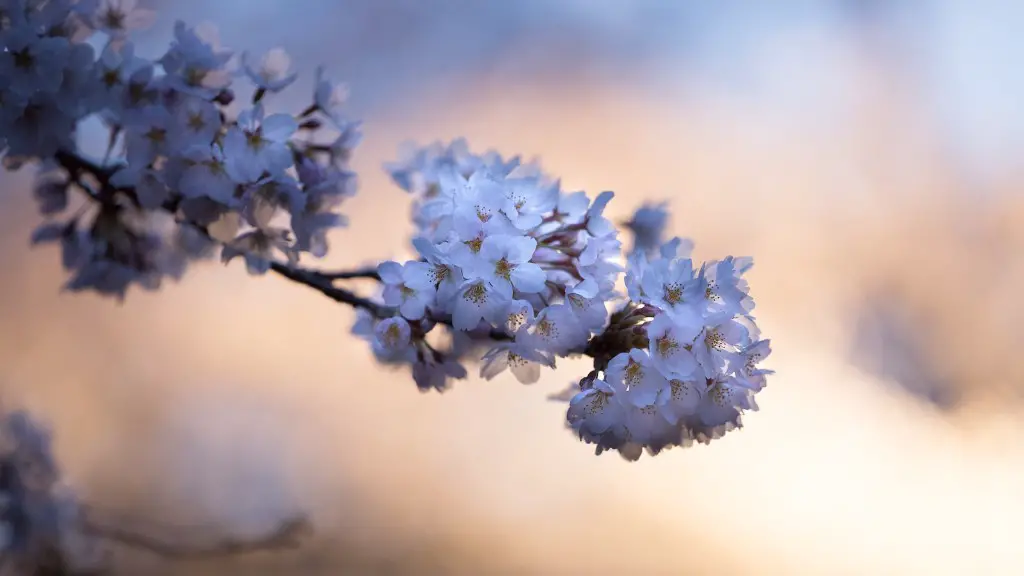Many people are surprised to find that their pretty cherry blossom tree apparently refuses to flower in the spring. Without an understanding of the physiology of the tree, it can be difficult to troubleshoot the problem. In this article, we explore the reasons why a cherry blossom tree may not flower and what can be done to encourage new blossoms.
Background
Cherry blossom trees are a type of flowering tree belonging to the genus Prunus, of the Rosaceae family. These trees flower in the spring, often producing abundant and showy blossoms for a couple of weeks. The blossoms are an important aspect of the ecology of the tree, attracting pollinators and providing the tree with reproductive opportunities.
Environmental Factors
When a cherry blossom tree fails to flower, environmental factors may be to blame. Flowering is triggered by a combination of temperature and sunlight levels. If the tree has been exposed to an unusually cold or dry winter, or if it has been subjected to excessive pruning, it can prevent it from flowering. Further, a young tree may require several years of growth before it is capable of flowering.
Nutritional Deficiencies
Nutritional deficiencies can also inhibit flowering. Plant experts typically recommend the application of a balanced fertilizer, applied regularly in the spring, to ensure adequate nutrition for the tree. A diagnostic soil test can be used to determine the available macronutrients (nitrogen, phosphorus and potassium) in the soil.
Pest and Disease
Inspect the tree for signs of pest or disease damage. Aphids, scale and mites can be controlled with regular application of insecticidal soap, and disease can be managed by treating the tree with a fungicide. If not addressed, pests and disease can inhibit flowering or cause the tree to drop buds.
Overwatering
Overwatering can also prevent the tree from flowering. Cherry blossom trees require deep but infrequent watering to ensure moisture reaches the root system. Too much water around the roots can drown the tree and lead to a lack of blossoming. Instead, it is recommended to water the tree deeply and then allow the soil to dry out between waterings.
Sun Exposure
180-degree sun exposure is recommended for optimal flower production. If the tree is planted in an area of partial or intermittent shade, the blossoming may be reduced. If this is the case, it is advised to prune away any branches that might be casting shadows on the tree and investigate ways of increasing the amount of direct sunlight that reaches the tree.
Growing Conditions
Cherry blossom trees prefer acid soil that has a pH between 6.0 and 6.5. If the soil is too alkaline or too acidic a lack of flowering could result. Finally, cherry blossom trees require good aeration and drainage. Poorly-draining soil can be a culprit.
Improving Soil Quality
If the soil quality is not up to par, improvement methods such as the addition of organic matter, integrating cover crops and improving soil aeration can be used to optimize the growing conditions. Applying mulch around the tree can help retain moisture, minimize weeds and provide nutrients. Moreover, soil organic matter provides a better home for beneficial micro-organisms.
Water Management
To ensure that the tree receive the right amount of water, it is advised to measure the amount of water used during each watering and place a rain gauge nearby. Irrigation systems can be used to automate watering and ensure the tree receives the water it needs, when it needs it. It is important to remember that effective water management involves not just replicating natural conditions, but also adjusting the water requirements depending on factors such as temperature and humidity.
Pruning
Cherry trees require pruning to encourage branching and facilitate flower production. Pruning must be done carefully and at the correct time of year. Pruning too late in the season can lead to fewer blossoms and an increased risk of disease. Pruning should be kept light, thinning out the branches and removing damaged or dead wood.
Fertilizers
Fertilizers can help increase the concentration of nutrients in the soil, optimize soil pH levels, and promote healthy and abundant flowering. Different fertilizer formulations are available, including organic and synthetic formulations. A slow-release fertilizer is recommended, as it will provide a steady supply of nutrients to the tree. If being used to correct a nutrient deficiency, a quick-release fertilizer should be used.
Conclusion
A lack of flowering in cherry blossom trees may have many causes, from environmental factors to nutritional deficiencies. Taking a proactive approach, with good water management, pruning and fertilizing, is the best way to ensure that the tree has an abundant flowering season. With some effort and attention, it is possible to restore a cherry blossom tree to health, encouraging the emergence of the beautiful pink blooms that these trees are famous for.


